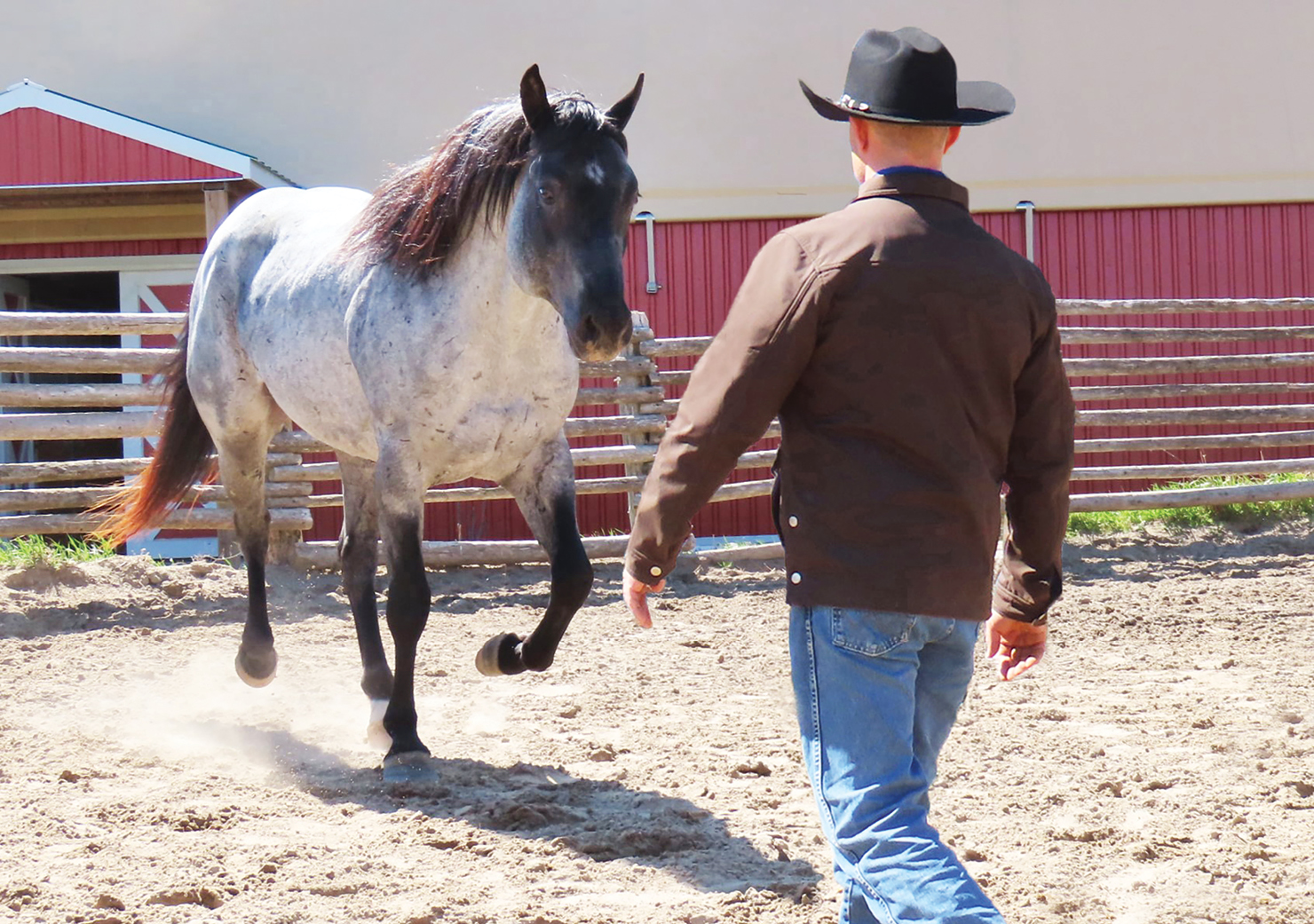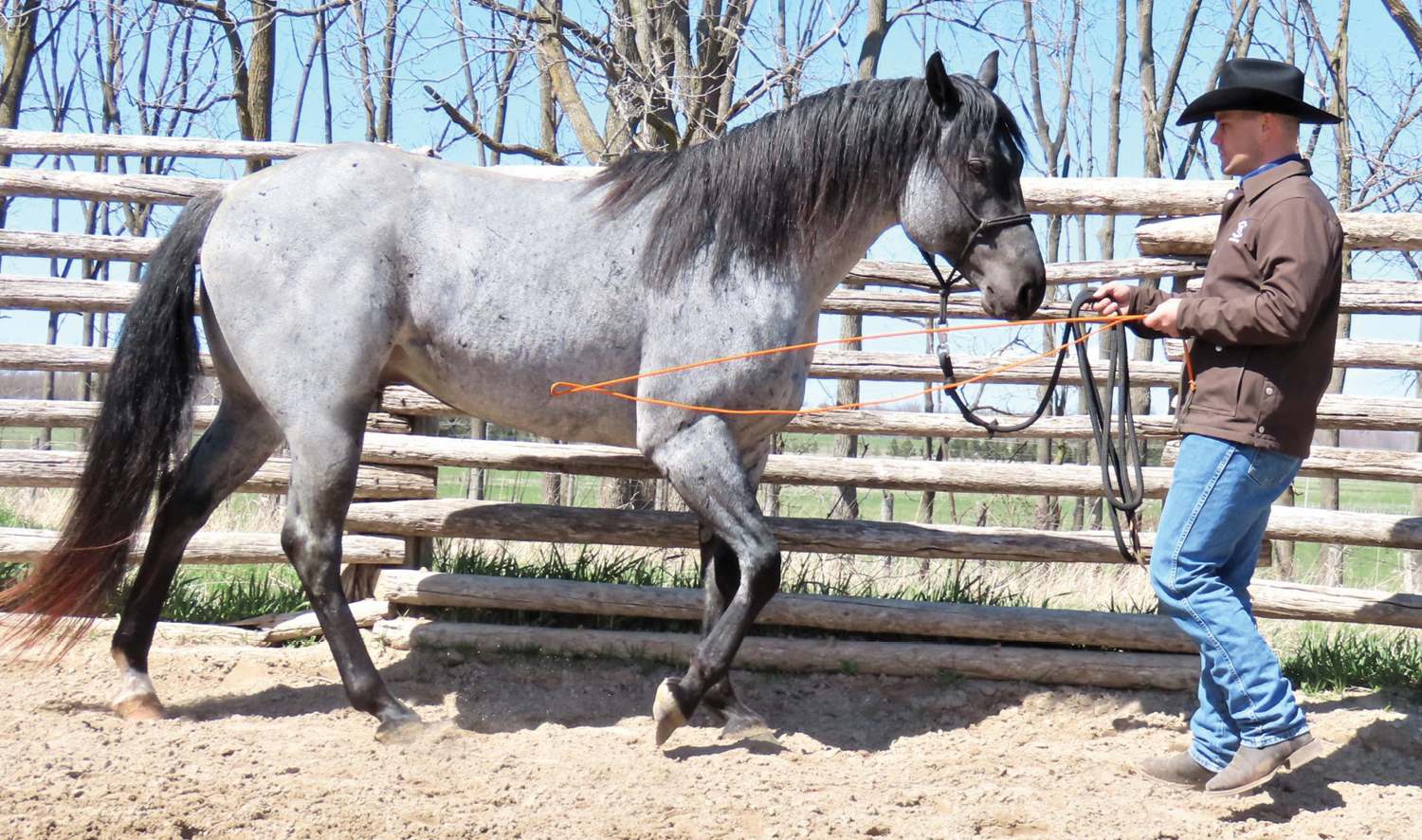Train your horse to come to your voice cue and build the bond between the two of you.
Does your horse turn and trot across the pasture or pen when you call him? I’ll show you a straightforward way to train him to come to your voice cue or whistle. You’ll need only a halter, lead, longe line, and longe whip (or training stick with lash), plus a
safely fenced small paddock or round pen. For your own safety, your horse must already have solid ground manners.

Before You Begin
Decide on the cue you’ll use to call him. It can be any short word (such as “here” or “come”), or a loud whistle. Don’t make it his name, as you use that at other times as well. This cue is exclusively to call him to you. Use it the exact same way each time; consistency will speed your results.
A note on treats: I rarely use food when training. If you want to reward your horse with a treat for coming to you, that’s fine as long as you don’t lure him with the food. He must learn to come to you at your call, and not because he sees food. So if you use food, don’t let him see it until after he’s come to you.
Teach the Basics
Start in your small paddock or round pen, with your haltered horse standing so his left side is beside the wall. Stand in front of and face him, as in the photos. Hold the lead rope in your right hand and the longe whip in your left. (Also hold the lash of the whip with your left hand so it’s not swinging around.) Allow about three feet of slack in the lead.
Then, ask your horse to come to you by giving the voice cue clearly and assertively, while at the same time taking one step backwards. The backward step will exert slight pull on the lead, and moving back creates a space that invites your horse to step into.
If need be, reinforce the cue with a light tap on your horse’s right shoulder with the end of the longe whip. The wall will keep him from moving left, and he won’t want to move towards the whip, so he should walk forward to you.

When he does, stop and rub or scratch him with the whip to reward him. You can also use your hand to rub and scratch, but doing it at least as much with the whip teaches him he has nothing to fear from it. (Obviously, you’ll use the whip only for this cueing and rewarding and not for anything aggressive or punitive.)
Repeat this entire sequence multiple times. As you do, try to avoid pulling on the lead rope as much as possible. You want your horse coming to you because you called him and stepped back. So when he doesn’t, use a light tap on the shoulder to bring him up to you.
Continue until your horse is readily stepping forward the moment you give the cue and step back. Then turn him around on the fence, reverse all your cues, and practice it in the new direction.
[RELATED: 4 more great groundwork exercises.]
Add Hustle
When your horse is solid coming forward on cue at a walk, add a bit of hustle. Give the cue and step back as before, but once he’s walking towards you, begin jogging backward and see if he’ll trot to keep up with you. (Again, avoid pulling on the lead as much as possible.)
If need be, release the whip’s lash and flick it lightly toward your horse’s hind end. Once he trots a few steps, stop and reward him.

Now move on to calling your horse while he’s already moving. Still in the round pen or small paddock, put him on the longe line and move him around you at a trot. When you’re ready, call him with the cue and take a few steps backwards. He’ll already have the idea to come to you when he hears the voice cue and sees you backing up, but if need be the first few times you can reel him in with the longe line as you back up.
Repeat this step several times over several days, being careful not to give the feeling that you’re “chasing” him. Always keep the focus on coming to you at the cue.
[READ: Round Pen 101 with master horseman Clint Haverty.]
Add Freedom
When the longe-line work is solid, detach the line and move on to calling your horse while he’s loose. Get him quietly jogging about the paddock or round pen. Then, at a moment you can see his focus is on you, step backwards and give the voice cue.
If he turns and trots up to you, give both him and yourself a pat. If he doesn’t, try again, even going back to work on the longe line if need be to reinforce the cue.
Gradually reduce the amount of moving him around you do before calling him to you. Towards the end of the training, even if he’s standing still, you should be able to catch his attention, give the voice cue while taking a step or two back, and have him come to you.
Over time, cement the learning by practicing it in other enclosures that aren’t too large—his stall, additional paddocks, a small arena, etc. It may take a few weeks, but the end result—a horse that comes when you call and step back—is well worth it.
Book: 101 Ground Training Exercises for Every Horse & Handler (Read & Ride)
Products we feature have been selected by our editorial staff. If you make a purchase using the links included, we may earn a commission. For more information click here.






